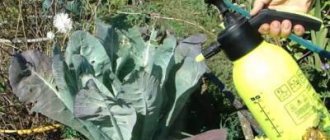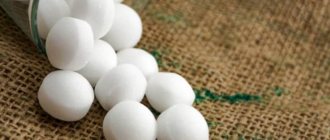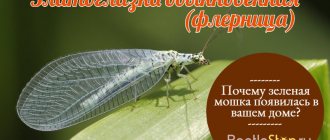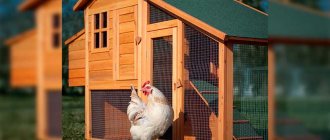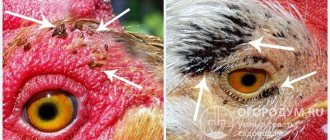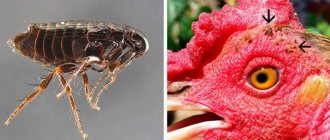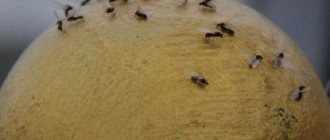Livestock buildings are a favorite habitat for zoophilic flies. Dangerous pests can significantly affect the productivity of animals, as well as become carriers of diseases such as helminthiasis, foot and mouth disease, anthrax, brucellosis, swine erysipelas, dysentery, plague and other infections. The optimal ambient temperature, as well as the presence of manure, silage, food debris, and other organic matter, create favorable conditions for the reproduction and active life of arthropod parasites. If no measures are taken to destroy them, the population can increase 3-5 times daily. Therefore, the question of how to get rid of flies in a pigsty, cowshed, stables and other premises where animals are kept is very relevant not only for livestock farmers, but also for rural residents.
On a note!
Up to 1000 pests can develop in 1 kg of manure.
The reasons for the appearance of flies in the chicken coop, why they are dangerous
Flies overwinter in the egg phase; adult flies lay them in shaded areas with high humidity. If the walking yard and chicken coop are located next to a beam, stream or any other body of water, then you cannot do without uninvited, buzzing guests. Flies are active from early spring to late autumn, in the morning and evening, but during large infestations they fly in the chicken coop and in the walking yard all day.
Attention!
The source of flies can be old trash or garbage, under which moisture is always stored, as well as food waste. It is advisable to place the poultry house at a distance of at least 15 meters from residential premises and pens with other animals.
In the poultry house, the flies feel at ease - they are nourished and warm. In small numbers, insects do not bother or harm chickens; on the contrary, they serve as additional food. But large hordes of flies can weaken the livestock; constant bites cause birds to behave restlessly, and laying hens do not need unnecessary stress. Chicks, pullets and broilers are especially attractive to insects.
Flies and midges are carriers of dangerous diseases; they can infect birds with leukocytosis, glanders, leprosy, tularemia, onchocerciasis, and anthrax. It is very difficult to cure adult chickens, and young chickens most often die.
Reviews
Evgenia. We have flies in the chicken coop when the gardening season begins. Behind the poultry house there are baths with water for irrigation; there is no other place for them. It’s clear - where there is water, there are dipterans. In the poultry house and in the yard where the chickens roam, I hang tansy and mint branches, periodically treat the room with Agita, a product sold in a veterinary pharmacy that kills not only flies, but also other insects.
Christina. The poultry house and pen are always clean, despite the recommendations, I clean the chickens very often (2-3 times a week). There are a lot of flies and mosquitoes, and there is a small stream running behind the site. We save the bird from insects with baits, and turn on insecticidal lamps and fumigators at night. In August, when there is a large invasion, you have to use chemicals, last year I bought Dobrokhim, the result was good, this year I want to try Byte.
Reasons for appearance
Small midges are frequent guests of chicken coops, especially in summer.
Most often they start due to high humidity. This happens mainly due to the close location of the poultry house to various bodies of water. These parasites begin to become active in early spring, and they are active until late autumn.
Another reason is storing old things, leftover food waste or forgotten garbage. All this must be disposed of in a timely manner, since this kind of trash is perhaps the main reason for the appearance of flies.
In addition, flies appear in the chicken coop for the simple reason that there are all favorable conditions for them: warmth and a source of food is close. In general, if there are few of these insects, then they are even beneficial, since they are excellent as additional feeding for poultry, and they do not cause harm.
If there are a lot of flies, then they can annoy the chickens, causing them stress. Such anxiety will be especially harmful for laying hens. Moreover, flies and midges are the main carriers of various diseases, including leukocytosis, glanders, tularemia, onchocerciasis and anthrax. Treatment of an already fully formed adult chicken will be difficult, but young birds for the most part die.
Description of the pest
Almost everyone knows what most types of flies look like. This is a small insect, about 8 mm long, with a hairy body, usually gray or black, and one pair of transparent membranous wings. The paws have sharp claws and sticky pads, which allows them to move on any surface. The organ of smell is the antennae, with the help of which they sense odors many meters around.
The eyes of these pests have a special structure. There are five of them in total: three eyes are located on the midline of the forehead and two large eyes on the sides of the head. The large eyes are made up of thousands of hexagonal facets. This arrangement of the organs of vision allows you to see everything around at 360 degrees, so it is almost impossible to catch it simply with your hands.
Fly
The mouth has a licking-sucking structure, a kind of proboscis acts as a mouth, therefore flies feed mainly on liquid food, solid food must first dissolve in saliva.
These pests multiply very quickly. A female can lay more than 6 clutches over the summer, and each clutch can contain more than 1800 eggs. Life expectancy is approximately 2-4 weeks, depending on climatic conditions, so up to 20 generations can change over the summer!
Why are flies dangerous?
Favorable conditions for living are places where garbage, dirt and various waste accumulate. They feed on the products of decomposition of organic waste. Since there are many different pathogens in the garbage, pests on their legs transfer them to the food on which they crawl.
Flies on food
Thus, food may contain pathogens of intestinal infections, tuberculosis, cholera, dysentery, helminthiasis, salmonellosis, ascariasis, and sometimes more dangerous infections - for example, anthrax. Some species may bite humans when the risk of infection increases.
In addition, flying parasites can lay eggs on bread, which, when eaten, enter the human body and cause intestinal myiasis, the consequences of which can be very dire.
What flies live in the chicken coop?
Any insect can enter a chicken coop, just like a house. Unfortunately, there are flies that not only settle next to birds, but also reproduce. Most often found in a chicken coop:
- Blowfly. The adult reaches 25 mm. The color of the insect is gray. On the back there is a characteristic pattern in the form of a chessboard. On the head there are 2 large compound eyes of bright red color. The wings are transparent. The insect feeds on decaying foods, including corpses;
- Gadfly. An adult insect reaches 15 mm. Color – yellow with black spots on the back. A distinctive feature is the villi throughout the body. There are 2 large eyes on the head.
Important: pest larvae are capable of eating the flesh of a living animal or bird.
Features of wrestling
It is not always possible to use insecticides indoors with livestock. One of the main conditions is the absence of inhabitants at the time of processing the barn and for at least 2 hours after completion. After disinfestation, be sure to change the bedding, wash the feeders, and add fresh food. The effect of the chemical lasts no more than 3 weeks, and there is a need for re-treatment.
On a note!
In rooms where there are animals, there will always be flies. They are attracted by the smell of sweat, heat, carbon dioxide, the presence of feces, manure, rotting grass, and the presence of food. Insects are active during the day, when it is hot outside, windows and doors are open indoors. Flies freely get inside, feed, reproduce, and multiply.
To reduce the activity of pests, in most cases they use indoors all kinds of fly traps, baits, folk remedies, as well as poison, which is applied with a brush in places where livestock and birds cannot reach. The basic rule is to keep the shed clean, do not leave rotting grass in the room, and do not allow the presence of stagnant water.
Another effective method of controlling flies in a goat shed, cowshed, pigsty, or chicken coop is the treatment of livestock and poultry. In this case, folk remedies and professional chemicals are also used. It is important to follow the instructions, dosage, and frequency of treatment. Improper use of insecticides causes side effects and deterioration in the well-being of animals.
Home traps
Adhesive tapes against flies
Help against flies at the imago stage. The simplest option is adhesive tapes. Suspended from the ceiling in places where insects accumulate. Continue until the entire surface is filled. Safe, easy to use, but not very effective. Sticky tape is suitable for small insect populations.
A special trap in the form of a house, a jar with a hole in one or several places, lures insects with bait with a characteristic odor, without chemicals. An example of such a design is the SWISSINNO - Fly Trap. The range is up to 30 m. It is possible to buy bait separately or prepare it yourself. The price of the trap is about 700 rubles.
A unique window trap is produced by the Swiss company Swissinno. Installed on window sills, fits perfectly into the interior. Effectively catches insects and helps remove them before they enter the room.
You can do without store-bought means of destruction and make a trap or adhesive tape yourself.
Basic requirements for the construction of a pigsty
Building a pigsty is not as easy as it seems; this business has its own characteristics and difficulties. There are a number of requirements, the fulfillment of which is mandatory for the successful development of the economy. Among them:
Big square
- The building should be located on a hill - this will avoid excess dampness. You should not choose a place that can be ventilated - this way you can reduce heating costs;
- Big square. The pigsty provides both a place for living and for walking. Pigs require a lot of space. If you do not have enough space to contain the desired number of animals, you should not try to cram in as many as possible, this will greatly spoil the condition of your charges;
- Maintain a distance between the pigsty and residential buildings - at least 15 meters!
- Presence of all necessary communications. The proposed building must have water, electricity, gas if necessary;
- Resolution of the transport issue. You will have to deal with a large amount of waste that requires proper and timely disposal.
Failure to comply with these basic rules will primarily affect the farmer’s business, so this issue should be treated with due attention.
Manure removal process
Manure removal in a pigsty is an important point that directly affects the health of pigs. It can be performed with special equipment or hired personnel. If pig waste is not removed promptly, various problems may arise.
Devices for collecting manure work quite quickly and efficiently, so it is worth paying special attention to them. The equipment is divided into:
- Self-alloying system. Such equipment requires the installation of special pipes, containers and plugs. In addition, sections with animals should be at a slight slope. With the help of plugs and pipes, manure is transferred into the container. This equipment is the most popular and simple.
- Hydroflush. Suitable for small households, which is not very convenient. This device is durable, but very expensive both in price and in terms of resource costs. Cleaning is carried out using water. This type of equipment is not particularly popular.
- Delta scraper system. This equipment scrapes off manure with special shovels. It is very effective and popular in the market. It is worth giving your preference to this particular invention.
Self-alloying system
A room cleaning system must be present at any enterprise, because it will save effort and thoroughly clean the room. In addition, bacteria can be used for bedding in a pig barn. This is something akin to a dry closet. Bacteria trap odor and moisture, so the room remains clean and dry for a long time. This will help save money and make your work easier.
There are a lot of flies in the dacha, what should I do?
If you live in an apartment, you can get rid of flies with the help of plants. This method is also suitable for summer residents. Only the plants will have to be grown not in pots, but on a personal plot. Below is a list of plants that repel flies.
Plants that repel flies:
- Bird cherry
- Tansy
- Bay leaf
- Geranium
- Basil
- Peppermint
- Tomatoes
- Carnation
- Lavender
These plants will help remove a lot of flies from your dacha. It is best to place them in pots, or plant them in an area near areas where garbage is stored and compost is prepared. This will help get rid of insects.
Plant predators
Is it possible to warn?
As you know, prevention is the best solution to any problem. Flies and flies will be no exception. When removing pests, you need to make it a rule:
- be thorough with cleaning;
- repair all leaks in a timely manner;
- protect windows with nets.
You should get into the habit of throwing out trash every day and disposing of spoiled food as quickly as possible. Containers with honey, jam and other products attractive to insects should not be left open. After washing, fruits and vegetables must be dried and stored in a place protected from pests.
You won’t have to deal with flies and flies if you regularly ventilate your entire home, including the bathroom. High humidity is a comfortable environment for insects to breed, in contrast to cool, clean and dry air.
Another preventive measure is growing house plants. Thus, geranium perfectly drives away flies with its specific smell, so it is recommended to place a pot with such a plant on each window. If you don’t want to grow greens at home, you can get into the habit of fumigating your home with an aroma lamp.
Both large flies and small flies are a problem, but fortunately a fairly easy one to solve. Knowing where insects come from, how to get rid of them and how to prevent re-infestation of your home, you can live in cleanliness and comfort without harmful “neighbors”. These measures are quite simple and accessible to everyone, so you should not neglect them, because the dangers associated with flies are really serious.
How to get rid of flies in a poultry house without harming the chickens
Methods and means of control are selected based on the number of insects. If the population is small, it is better to use plant repellers or special traps prepared according to folk recipes. Chemical treatments are carried out only in cases where there are too many flies.
Before using any method, you need to remove the source of the problem, if possible (old logs, household and household waste). When getting rid of adults, do not forget about eggs and larvae; it is impossible to kill them without the use of potent drugs; use long-acting products.
Folk remedies (traps and repellers)
To make the chicken coop as unattractive to flies as possible, you can plant plants around it that they don't like the smell of. For example, chamomile or feverfew, wormwood, tansy, basil, garlic, mint and lemongrass. If it is not possible to sow herbs, they are collected in bunches and hung throughout the area where the bird is located. Planted or hung grass should be kept out of reach of chickens.
Wormwood can be used in another way - dry a bunch of herbs, set fire and fumigate the room, leave the remains of the still burning herb in a metal bucket, let them smoke, leave the room for an hour. Before the procedure, the chickens need to be kicked out of the house and all windows and doors closed. To protect yourself, wear goggles and a mask to prevent smoke from entering your respiratory system.
Attention!
Flies are attracted to bright sweets; bright food colorings can be used when making bait liquids.
We will not describe all possible types of fly baits; they are based on the same principle. Let's highlight the most interesting, tried and tested options.
| Fighting method | Description |
| Plastic bottle | The top part of the bottle (with hangers) is cut off, the resulting container is filled one third with a solution attractive to insects - 1 part dishwashing detergent, 3 parts sugar and 1 part apple cider vinegar. Remove the cap from the cut-off part of the bottle and place the funnel, neck down, in a container with bait. The fly will fly to the smell, crawl into the trap, and will not be able to get back out. |
| Glass and cling film | A glass or any other container is filled almost to the top with sweet bait, covered with film, and secured with thread or an elastic band. Using a knife or scissors, make small holes on the surface of the film through which the fly will crawl to the bait and immediately drown in it. |
| Black pepper | Pour 4 tablespoons of sugar and 2 tablespoons of ground black pepper into a glass of water, stir until the sugar is completely dissolved, and leave for a couple of hours. The solution is poured into small containers and placed in the poultry house so that the chickens cannot reach them. You should not expect instant results; the flies will die 2 or 3 days after they try the bait. |
Essential oils can be used as deterrents. Extracts from plants such as cloves, lavender, eucalyptus, lemongrass and mint are suitable. Oils can be poured into bottle caps and placed in places inaccessible to birds, or you can mix them with water and spray them on the walls around windows and doors, above perches and feeders.
Mechanical methods of struggle
In the case of a chicken coop, when we talk about a small number of flies, this means one or a couple of dozen insects. Of course, catching them with your hands and destroying them with a fly swatter is extremely inconvenient, but there is no need to use chemicals either. A simple solution to the problem would be special adhesive tapes. When hanging them in the chicken coop, try to choose places that are difficult for chickens to reach and where there is plenty of light.
You can make your own sticky tapes. Baking paper (parchment) is cut into ribbons 2 cm wide, the length can be adjusted at your discretion. Make a hole in each strip and thread a thread through it for hanging. For this method, it is advisable to prepare the following solution:
- take 1 part sugar and 2 parts maple syrup;
- mix the ingredients in a bowl, heat, but do not bring to a boil;
- stir until the sugar is completely dissolved and cool.
The strips are placed in a container with the prepared mixture, covered with a lid and left for 10 or 12 hours to soak. After that, the ribbons are dried a little in the sun and hung in the chicken coop.
Attention!
It is not advisable to install mosquito nets in the chicken coop; chickens should be able to enter and exit the premises without hindrance.
You can find special insecticidal lamps on sale. Their work is based on the fact that insects fly to the light, fall on the internal metal grid, and die from an electric current. The device is safe for birds.
Proven chemicals
Before using any chemicals, chickens are taken out of the room, containers with food and water are taken out, as well as “bathing baths” with special mixtures. It is also advisable to remove bedding from the floor and perches. Let's highlight the best drugs recommended by experienced poultry farmers:
- Agita - the product is sprayed on walls that are exposed to sunlight or light from a lamp; the substance acts when heated. Granules can be scattered in places inaccessible to birds. The working solution is prepared from 25 grams of the drug per 200 ml of warm water. The liquid is thoroughly mixed, poured into a sprayer and the room is treated. The effect lasts for 2 months.
- Byte granules are scattered on substrates in places where insects accumulate. The insecticide affects pests 15–30 minutes after eating. Byte contains a sex pheromone and sugar that attracts flies, the product is effective within a radius of 1 meter. It also contains a bitter substance that prevents birds from eating the pellets. The bait is valid for 3 months.
- Delta Zone - the result of using the product is noticeable immediately after treatment, the effect lasts for 2 months. Delta Zone does not have a strong chemical odor and does not harm the bird. To combat imagoes, prepare a solution of 15 ml of the substance per liter of water, and with larvae, take 15 ml of the product for the same amount of water. The solution is used to treat areas of greatest concentration of flies or the entire room.
- Dobrokhim Micro - the product is effective for 6 months after treatment, effectively kills flies and is not dangerous for chickens. The substance harms not only adult insects, but also larvae. You will need 7 ml of the substance per liter of water; you need to treat walls, window frames, door frames, and places where flies are most concentrated.
- Medicil Cyper - after the first treatment, up to 97% of insects die, the effect lasts up to 2 months. The product destroys pests even in open areas. To prepare a solution, take 4 ml of the substance per liter of water, treat the places where flies most often fly, walls and openings (doors, windows).
When dealing with flies in a chicken coop, do not try to save money. Some cheap products, despite a beautiful description, may not be cleared from the room for a long time. After treating the chicken coop with any of the described preparations, the chickens are allowed into the room no earlier than 2 hours later. When working with chemicals, use personal protective equipment - rubber gloves, goggles, mask.
Attention!
Flies quickly develop immunity to the same drug, choose a couple of options, alternate drugs.
How to make bait
A glass jar would be an excellent trap for fruit flies:
- In an ordinary glass jar we place a delicacy for the fly, for example, a little fermented compote or fruit;
- make a cone out of paper or cardboard with a small hole at the tip;
- We lower a homemade “funnel” into the neck of the jar, and seal the joints with tape.
A disposable cup will also come in handy:
- put a suitable bait in a plastic or paper glass;
- Cover the top with cling film;
- Use a needle or toothpick to make several small holes in the film;
- We place the glass in the place of the greatest concentration of flies.
A plastic bag can also do a good job. As soon as you put something sour or fermented in it, fruit flies will immediately flock to its aroma
When the number of muses in the bag reaches its maximum, you just need to tie it very carefully so that all the insects remain inside. Then feel free to take the buzzing bag out of the house.
In addition to combating the use of homemade traps, industrial achievements can also be used. There are glue traps specially designed for fruit flies on the market. They have proven themselves excellent among home winemakers.
The principle of operation is that the trap is a “house” with sticky sides that emits an aroma that attracts fruit flies. The effect of one such trap lasts up to 30 days. It is also good because you can safely install it in close proximity to food. How to destroy fruit flies
So, if you know how fruit flies appear, then you already understand that the best remedies for small flies are to deprive them of a fertile environment for reproduction and nutrition. That is, the first thing you need to do is to remove “out of the way” everything that this thin-winged army flocks to.
Pests will be discouraged if fruits, berries and vegetables no longer appear in your kitchen (all of this can be stored in the refrigerator, where pests are not allowed access due to unfavorable temperature conditions). Remove old supplies immediately, just throw them away. It’s better to take the trash bag out of the house right away, because the trash bin will not help you remove the fruit flies.
Mechanical methods of control
To remove flies from the poultry house, you can also use mechanical methods. There is no need to catch flies with your own hands or use a fly swatter - it will be enough to buy a special adhesive tape, or better yet several, and hang them in the room where the birds live. It is recommended to choose places for placing the tapes where there is a lot of light and where it will be difficult for chickens to reach.
You can, of course, install mosquito nets in the chicken coop, but this solution is unlikely to be advisable: the bird still needs to be able to enter and exit the chicken coop without any obstacles.
Alone, but very annoying
The behavior of the only fly in a home can also tell a lot to a knowledgeable person.
- If an insect desperately rushes around the rooms and buzzes loudly at the same time, then one should expect a noisy scandal in the family. Yes, this is not surprising, considering that the unbearable creature is capable of unbalancing even the most imperturbable person.
- A fly not only flies around the house, but also pesters its inhabitants, and sometimes even bites? Ahead is a change in the weather for the worse: cold and prolonged rains.
- The worst omen is to find a fly in the house in winter
. She predicts that there will soon be a dead person in the family. - If you caught an insect from a mug or plate, then you are unlikely to be happy about it. However, there is a consoling sign in this regard, promising a gift or other pleasant surprise.
- Another unpleasant contact with a fly occurs when it unceremoniously lands on a person
, choosing the most inappropriate places. If it lands on your hair - you will have to be separated from your loved one, if you choose the nose as a landing spot - you will have to drink, if it gets into your eye - you will cry, if it gets into your ear - you will make a mistake in making a decision. If God’s creation flew straight into the mouth, then the sign warns that one must first think, and only then speak.
What awaits you in the near future:
Find out what awaits you in the near future.
Being a rather harmful insect that causes a lot of inconvenience to a person, a fly can also portend various events in the house of those people it has flown into, both pleasant and not so pleasant.
First actions
If flies appear in the house, act immediately.
- Conduct an audit in the kitchen.
- Throw away food waste, pack food in sealed bags, hide it in a closet or refrigerator.
- Wash work surfaces, trash cans, and floors with a mild rinse of table vinegar.
- Install a mosquito net on the windows and vents. A durable product with small cells is a reliable barrier not only for flies, but also for mosquitoes.
Clean regularly, do not allow food to spoil, and take out the trash can every day. Such actions significantly reduce the number of flies in the apartment.
In a private house and country house, a breeding ground for insects is a cesspool and a toilet. To neutralize sewage, use bioactivators that process waste, feces into liquid, reducing their volume, and call a sewer truck more often.
Prevention
Prevention has always been more convenient than the subsequent war for the title of “master of the house.”
Description of preventive measures:
- Using mosquito nets on windows, vents, and ventilation openings. The house should not have any cracks/loopholes for uninvited guests.
- Follow sanitary and hygienic rules in the house, clean regularly, do not leave various waste, and throw out garbage in a timely manner.
- The trash can must have a tight-fitting lid.
- Flies cannot tolerate drafts, so in the summer it is useful to ventilate the house as often as possible.
- Do not leave crumbs or leftover food on tables; if necessary, cover food with a net or towel.
- Flies like to breed their offspring in the soil of indoor flowers, so it would not be superfluous to clean or change the soil, at least its top.
- When cold weather sets in, flies look for a suitable secluded place in basements and attics. These premises should be inspected, destroying sleeping individuals.
- Make sure that vegetables or other products stored in cellars do not rot.
- If the owners prefer to keep the front door open for ventilation in the summer, then it would be a good idea to hang sticky tapes in the corridor.
Fly repellent for chicken coop
Now you know what to do if you are overwhelmed by flies in the chicken coop. By the way, apples and pears from the garden also attract flies, so give the hens a little at a time so that they peck them right away.
Good luck to you!
Subscribe to the channel “Chicken”
. Let's take care of poultry together.
Like
harmless advice against flies.
See you! In the meantime, we will prepare for you new useful information about keeping laying hens, hens and quons at home.
© All about chickens 2022. All rights reserved.
Improvement of the ventilation system
Regular ventilation is necessary, but what to do if it’s cold outside? Pay attention to ventilation: the barn should be well ventilated. It is recommended to carry out cleaning 1 – 2 times a month (when using bedding). Try to add soda and citric acid to the cleaning solution, which are harmless to animals.
Caring for a barn is quite simple; it is only important to follow the recommendations of specialists.
Don't forget to like and subscribe
to our channel;)
Preventive control of flies in winter
In recent years, during mild winters, farmers and private farms have turned their cattle out to pastures, where the cows feed on hay from abandoned stacks. A mixture of hay and excrement forms on the ground around the stacks. By spring it becomes an ideal place for flies to breed. Therefore, at the end of spring, it is better to treat these places to kill flies. Data shows that between 20 and 60% of the hay is scattered around the stack by cows. Periodically it would be possible to remove this mixture, thereby combating flies. But storage will create even more favorable conditions for parasite larvae. Sampling studies indicate that the destruction of flies must be carried out in a circle with an area of 300 m2, which is formed from an old haystack with a diameter of 3 meters. More than one million individuals can emerge from such an area. A preventive measure to control flies is the use of insecticides in early spring before the emergence of adult flies from these areas.
Features of the microclimate in the barn
The principle of organizing air exchange in a barn
Keeping pets and poultry in a barn requires effective ventilation. If in the summer the inhabitants of the barn stay in it only at night, and the rest of the time the room is ventilated, then in the autumn-winter period and early spring it is inhabited around the clock. The accumulation of large livestock, the heat and carbon dioxide they produce, waste products - all this affects air staleness, lack of oxygen, if ventilation in the barn is absent or performed incorrectly. Air exchange can be:
- Natural. Air flows penetrate and are removed from the room through specially equipped channels. Air movement occurs due to the difference in pressure inside and outside the barn.
- Forced. The air is moved by the vacuum or pressure created by the fan.
The first type of ventilation is economical and suitable for a small room designed for an equally small number of birds or animals. There are 2 pipes with a cross section of 150-200 mm. One of them protrudes slightly under the ceiling, the other (supply) does not reach the floor surface by 0.3 m. This is the simplest solution to the issue of barn ventilation, which is easy to do yourself. The second type is more effective because harmful secretions are removed forcibly. The fan used for this is mounted in a window or ceiling.
Feed additives
Most owners purchase ready-made food. The manufacturer promises: the nutrition is balanced, the cow does not need to be fed anything else. However, experienced farmers notice that the animal becomes more lethargic, milk yield is low, and diseases appear more often. To support the animal, use feed additives.
One of the most popular and inexpensive is EM “Baikal”. The drug contains probiotics that promote better metabolism. For 1 kg. live weight you need 3 - 4 drops of the substance. It is recommended to use undiluted.

